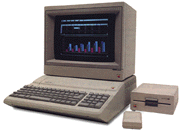 The Apple
IIe
The Apple
IIe Released in January 1983,
The Apple IIe was to be one of the most successful Apple
computers ever. It was based on the 65C02 processor,
which could run at 1.02 Mhz. It came with 64K of RAM and
a 32K ROM which included BASIC, an assembly language
interface, and several other hard-coded options. The Apple
IIe originally sold for $1,395,
and had a number of
improvements and facelifts until
it was finally discontinued in
mid 1993, making it the only
Apple computer be in
production for more than 10
years. (pictured left is the
updated Apple IIe "Enhanced", circa 1987)
The Apple
IIe originally sold for $1,395,
and had a number of
improvements and facelifts until
it was finally discontinued in
mid 1993, making it the only
Apple computer be in
production for more than 10
years. (pictured left is the
updated Apple IIe "Enhanced", circa 1987)
Date: Wed, 5 Mar 1997 14:19:10 -0800 (PST)
From: john.huber@etak.com (John Huber)
To: opinions@apple-history.pair.com
Subject: Apple History suggestion
You should mention that the Apple IIe included the new ProDOS
operating system, which was essentially a port of the Apple III's
SOS. ProDOS made the IIe the easiest-to-use computer of its time.
Date: Fri, 7 Nov 1997 04:09:35 -0500 (EST)
From: Neil McNeight
To: opinions@apple-history.pair.com
Subject: Apple IIe and ProDOS
On your site, it mentions that "the Apple IIe included the new
ProDOS operating system". This is not entirely true. It is true that the
IIe was the first Apple that was shipped with ProDOS, but the first
IIe's came with the then standard of DOS 3.3. It wasn't until 1984 or
so that ProDOS came around.
Date: Wed, 12 Nov 1997 10:21:34 +0000
From: Sidney A Powers
To: glen@apple-history.pair.com
Subject: Apple IIe
With regard to your histories of the II series. The II and IIplus had
ony upper case letter capability built it. There was a software
enhancement that allowed one to use lower case letters but as I
remember it, the software was not user friendly. The one big
improvement on the IIe was a built-in capabily for upper and lower
case usage. That was a big step forward.
Date: Fri, 21 Nov 1997 22:13:56 -0500
From: Peter Chin
To: glen@apple-history.pair.com
Subject: Nit - picking / Apple IIe
I don't remember this 'software' modification. What I do remember is
that there were basically two ways lower case got supported on the
II/II+ series:
- Have the program offer its own kludge. Magic Window II, ScreenWriter I & II, Bank Street Writer, among others, allowed you to use the "ESC" key to toggle between upper and lower case. On machines like the upgraded II's and II+'s this was the only way to get lower case input.
- Perform the 'Shift Key" modification.
You ran a wire from the keyboard encoder to a pin/contact on the game controller input socket. Wacky, but it worked. What was even more incredulous was that most word processors that were written for the II/II+'s encouraged you to do this on your own or to get the dealer to do it, or you wouldn't get the most out of their programs!
Top Picture: Personal Computing Magazine, 11/84
Bottom Picture: AppleDesign